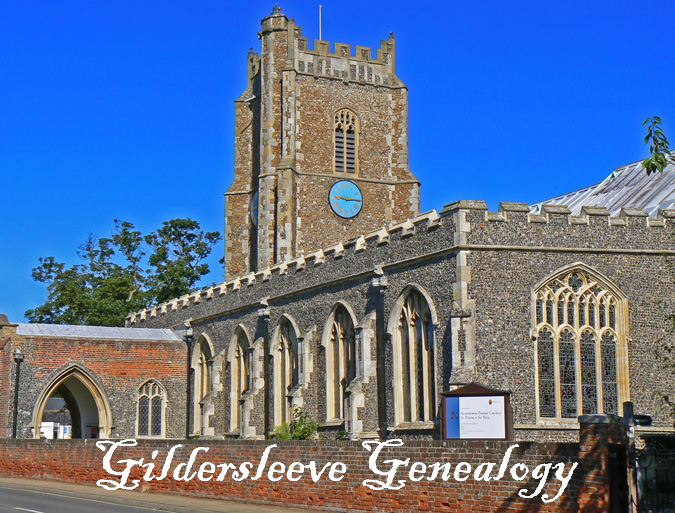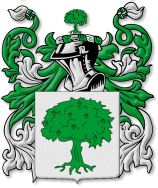 |
|
The first mention of the surname Gyldensleve can be found in Vol. 5 of "Herald and Genealogist", page 100, where the name appears as 'Gervase Paganel de Gyldensleve, cup bearer to Henry II, and then Richard I, from 1165 - 1200, who married Isabella, daughter of Robert de Bellemont, Earl of Leicester.' If we translate this as "Gervase Paganel of the 'Gilded Sleeves', the inference is that the 'Gilded Sleeves' had been the insignia of office of the cup bearer before this time. From 1165, back through a direct line of the four Lords of Dudley, appears the name of 'Gervase Paganel, Lord of Dudley', cup bearer to Edward the Confessor from 1042 to 1065, but nothing indicating an insignia of office.
From 1042, the Paganel family can be traced directly back to the time of Ahlmend, the Old Saxon King of Kent, 775 to 795.¹ The book Genealogical and Family History of the State of Connecticut, by an editorial staff including William R. Cutter, A.M., says that this possible ancestry is very much to be doubted, however (Vol. III, p. 1207).
All truly English names were invented later, in about 1340-1360. At that time, the Crown raised revenue by means of a Poll Tax—a flat-rate tax upon every adult male. Therefore, every man had to be identified. To distinguish between men of the same baptismal name in the same community (John, William, Robert, etc.), additional descriptions had to be conjured, for example, Black, White, Smith, Shepherd. Normally, readily understood adjectives were applied, so that there is no reason to suppose that two men of the same name, but from different places, were related.
So if the first Gildersleeve wasn't the cup-bearer to a king, he could just have been a man who was known to his neighbours by this peculiarity of dress (golden sleeves), so the term was applied to him—no different than calling him "Fancypants." However, most genealogists agree that it's hard to believe that two men, in different parts of the realm, would make the same fashion faux pas, so there is good reason to suspect that all those who now bear the name are descended from one man who lived about 650 years ago, and dressed a lot like Liberace. But as to whether he was the cup beareer for the King, or just a guy who like to dress with 'bling', nobody knows.
The first recorded use of the surname of Gyldersleve is with a man named ROGER GYLDENSLEVE, a land-holder in the county of Norfolk in the 'Hundred Rolls' list of 1273. But after that, there is no known documentation of that name—or any variation—for the next 150 years.
Then in 1421, JOHN GILDENSLEVE, Fellow of the Holy Cross Atteburg, is recorded in the county of Norfolk (according to Blomefield and Parkin's "History of Norfolk").
Then in the Subsidy Returns for 1524, there are six Gildersleeves: Jeffrey, John, Richard, Robert, Thomas and William. They resided in different places throughout England, like Suffolk at Blakenham, Elmsett, Grundisburgh, Mickfield, Stoke by Nayland, Thornham Magna, and Wetheringsett.
In 1568, Gildersleeves are recorded at Bricett, Brundish, Newton in Stow, Grundisburgh, Wetheringsett.
Then a JOHN GILDERSLEEVE is recorded as rector of Little Cressington, County of Norfolk, in 1588.
After that, the name of Gildersleeve appears very frequently in the records of marriage and wills in Norfolk and Suffolk counties. But it's hard to compose a reliable pedigree, because most parish registers begin only in about 1580, and there were few other sources available for common folk. But here's a list of the names that do exist, and some of those records that could be linked.
Parish Registers of Thorndon, Suffolk |
Our
direct family lineage can be traced back to this area of Suffolk, but the identities
of our particular ancestors are almost impossible to pinpoint. Commonwealth
Probates Vol. II, 1652-3 Part III, p. 273, states that the will of Richard
Gildersleeve of Groton, Suffolk, Dec 12, 1652 (Brent, 368) was probated on May
7th. But there was also a ROBERT GILDERSLEEVE, born about 1544, who married BARBARA
FAIRCHILD (b. Hedenham, England) in 1564,¹ Then there's RICHARD GILDERSLEEVE,
baptized in 1571. There's also a THOMAS GILDERSLEEVE, son of Thomas, born in 1561.
A
RICHARD GILDERSLEEVE was born about 1566 in Little Waldingford, Suffolk, England.
On October 17, 1591, Richard married married ANNA SWAYNE in Suffolk. It's hard
to say if this is the right Richard, but the date and place seem to work to make
him the father of...
OUR DIRECT ANCESTOR, RICHARD GILDERSLEEVE
Many
Gildersleeves sailed to the American Colonies the mid 17th century in the great
migration from Europe. Migrants settled in the eastern seaboard from Newfoundland,
to Maine, to Virginia, the Carolinas, and to the islands.
RICHARD
GILDERSLEEVE (1601 - 1681), was one of the first Gildersleeves to emigrate to
America. (A prominent professional genealogist has record of the baptism of a
Richard Gildersleeve in Suffolk, but because of the lack of specific identification
as provided by supplemental proof, and also because there may have been more than
one Richard Gildersleeve in the area, and, most of all, because of the fee—150
pounds—asked by this genealogist, members of the Gildersleeve family have
refused to purchase this information.)
Richard is said to
have been born at Aldeburgh Parish, on the North Sea Coast of England, in County
Suffolk, in 1601 (on page 149 of the Topocraphical Dictionary English Emigrants
to New England, 1620-1650). The church can be seen in the photo at the top of the page. Religion would play a huge part in Richard's life.
THE
MYSTERY OF MRS. GILDERSLEEVE
Prof. Willard Harvey Gildersleeve, a mid-20th century genealogist who did most of the work on the Gildersleeve family, however, disagreed: "Richard Gildersleeve 1st marrying a Joanna Appleton seems to be false---a hoax... This fairy story of Gildersleeves of Paganel, Earl of Dudley and Joanna Appleton as wife of Richard 1st is found in Vol. 3 of Connecticut Genealogy, p. 1023, published 1911-2. It was garbled translation from a vulgate Latin rendition of the purchase by Richard Gildersleeve and John Borcham.... in 1635 of the Appleton Manor in Groton and Combs, County Suffolk, England, from Samuel Appleton and wife Judith; Thomas Gostlyn and wife Jane or Joanna and Stephen Keable and wife Mariam. (What this actually does is confirm the existence of a SECOND Richard Gildersleeve in Suffolk, as our ancestor had already left for America.)
But we have to keep in mind several points:
Some genealogies also list Richard Jr's wife as "Experience," with no last name, supposedly married in 1625 (New England Marriages: Prior to 1700, by C. A. Torrey, p. 303). But if this is the right Richard, and he married again in 1625, his daughter—our ancestor, Elizabeth—was born in 1624. Did she have a different mother than "Experience?" (NOTE: Richard's grandson, RICHARD GILDERSLEEVE III, married a woman named Experience in the 1650's, so maybe this is what caused the genealogical confusion.) |
ANYWAY, BACK TO OUR STORY...
 The grave of Richard Gildersleeve today (read all about him in the New England Magazine, from February, 1893, Vol. VII, No. 6). |
The Puritans in Watertown, however, had established a theocracy which was even more intolerant than the Brits', and dissenters—including Richard and his family—left Massachusetts for religious freedom in Wethersfield, Connecticut, around 1636. (Richard seems to have been a restless spirit, for he is listed as one of the founders of seven different towns.)
The first winter in Connecticut was a time of suffering and hardship, because a boat with supplies for the immigrants froze in the Connecticut River, and never arrived. Beyond the weather, an Indian War, along with wolves, bears, and catamounts, threatened their lives.
Richard became a surveyor, as evindenced by the record of the court held Sept. 1, 1636, directing him to survey and inventory the estate of John Oldham, who had been killed by the Indians; also their records show that Gildersleeve was owner of 255 acres of land in that settlement. But before long he was on the move again. In 1639, he was on the list of the original settlers of New Haven Colony, moving to Stamford in 1641. He was elected in 1643 as deputy to New Haven Court, and helped to organize the United Colonies, the germ of the future United States.
Almost fifty citations from Oyster Bay town records testify to the active career of "Mr." Gildersleeve. He was one of the fifty original proprietors of Hempstead, Long Island, as listed in "Ye Mouseaton Book." He was one of the first to make allegiance to the English, being admitted as a freeman of Connecticut and appointed colonial commisssioner at Hempstead in 1644, and was Magistrate under the Dutch Governors of New York from 1644 to 1664, when New York was captured by the English.
In 1652, he moved again—to Middlesburg (later Newtown), Long Island, which he surveyed by Dutch orders, and was Magistrate. He then returned to Hempstead where he was magistrate in 1658. (July 10, 1658 - It is ordered and agreede by general vote ye Mr. Richard Gildersleve, according to appointment is to go to Mannatens to agree with ye Governor concerning the tytles and therein is ordered not to exceede one hundred scheepels [sic] of wheate [and if required] it is to be delivered at the towne habour and the charge of his journey is to be defrayed by the towne.)
Events in Richard's career which led to the American Revolution were his leadership in exposing Captain Scott's conspiracy to take over Long Island, as recorded in Hartford in 1664, and helping lead the revolt against the Dutch; Under the Duke's Laws, he was elected constable in 1668, and was attorney for the town 1665-1677. Due to the Duke's Laws, he started the organized agitation for self-government, representation, checking patents within patents of land, and for the rights of Englishmen. He and his son Richard were signers of the Hempstead Petition of 1669, the first recorded document of "No taxation without representation" in the English colonies; and lastly, his long and active fight in defending the rights of his town, and the inherited "rights of an Englishman," in the "patents within patents" hearings and lawsuits before the Governor's Council and the various courts of New York.
At some point after his immigration (maybe after getting driven out of Watertown by the Puritans), Richard converted and became a Presbyterian. However, Hempstead was not exempt from the religious troubles. In this period, Quakers wandered through the town and by holding meetings and making converts.
O'Callaghan in his 'History of New Netherlands' relates this account: "Richard Gildersleeve, a magistrate of Hempstead was one of the most prominent persecutors of the new sect. To hold the 'garments of those who stoned the saints' was not glory enough for him. He pursued them with proclamations and inflicted on them and their friends, pains and penalties without end. Hodshone, whilst peacably walking in an orchard was seized and brought before this man, who committed him and then proceeded to the Manhattans to acquaint Stuyveseant with the fact. Returning in a short time with the Fiscaal and a guard of musketeers, they seized Hodshone's papers and Bible, then pinioned their prisoner, and thus kept him during the night and the following day, etc."
Henry Onderdonk, Jr., in his "Quakers of Hempstead," gives this account: "There lived in the village, Richard Gildersleeve, a Justice of the Peace with Stuyveseant's commission in his pocket. He had perhaps been notified to be on the alert to put a stop to such irregularities. Be that as it may, as soon as he was aware of the intended meeting, he issued a warrent to the constable to arrest the preacher. The officer arrived on the ground a little before the hour for the meeting, and finding Hodgson "pacing the orchard alone in quiet meditation," he laid hold of him at once, and haled him to the magistrate, who left him a prisoner in his own house, while he (the justice) went to the Presbyterian Church (Mr. Denton's) for morning worship. But the wily Quaker outwitted the magistrate; for during his absence the prisoner by his loud and energetic action (probably in preaching from a window), had collected a large crowd of listeners, 'who staid and heard the truth declared'" Mr. Gildersleeve was so annoyed, on his return home from worship to find his dwelling had answered all the purpose of a chapel, that his prisoner had so favorable an opportunity for spreading his doctrines, and that he could not stop his mouth, that he instantly wrote a mittimus for his removal to another house, for Hempstead did not then boast of a lockup or house of detention."
Richard, now in his eighties, was on the Hempstead 1683 tax list. For a time he lived in Stamford, and he was one of the largest land holders. (Read all about him in The New England Magazine, from February, 1893, Vol. VII, No. 6.)
Richard died in @1685 in Hempstead, Nassau, Long Island, New York. He had several children:
CHILDREN OF RICHARD GILDERSLEEVE |
|
The Gildersleeve clan then went about controlling the town of Hempstead: The town records show that on May 12, 1680 the old meeting house and the town fort were sold at auction to Richard Gildersleeve---excepting the part of the fort that stood on the land of Jeremy Wood. Richard paid two pounds, 12 shillings for the property. Jeremiah was elected townsman at Hempstead on February 3, 1662, in company with brother-in-laws John Smith and Richard Gildersleeve, Jr.
The Colony of New York belonged to the Dutch, but King Charles II gave the land to his brother, the Duke of York, in 1664. When the British came to take the colony, the Dutch, who hated their Governor Stuyvesant, quickly surrendered to them. The Dutch retook the colony in 1673, but the British regained it in 1674, and the Gildersleeves kept their control of town affairs.
Jeremiah and Elizabeth Wood had several children:
KIDS OF JEREMIAH WOOD AND ELIZABETH GILDERSLEEVE |
|
|
The
Gildersleeves remained on the east coast for many years. Two were Tories, and
twenty were recorded for the colonist's side in the American Revolution.
Eventually,
many of them made their way west. Fortunately, they have stopped wearing the golden
sleeves.
GENEALOGY RICHARD GILDERSLEEVE (1601 - 1681) married JO ANNA APPLETON (or somebody) and begat... ELIZABETH GILDERSLEEVE (@1620 - ?), who married JEREMIAH WOOD (1620 - ?) and begat... JOSEPH WOOD who married EUNICE JARVIS in 1680 and begat... JOSEPH WOOD, JR. (1680 - ?) who married MARGRIET (MARGARET) WOOD and begat... JONATHAN WOOD (1720 - ?) who married JOHANNA CROMPTON (1725 - ?) and begat... MARTHA WOOD (1753 - 1822) who married WILLIAM HAUSE (1750 - 1818) and begat... JOHN HAUSE (1773 - 1844) who married ESTHER KETCHAM (1779 - 1853) and begat... AUGUSTUS HAUSE (1804 - 1875) who married JANE JONES (1802 - 1850) and begat... LABAN HAUSE (1831 - 1906) who married MELISSA SANDERSON (1839 - 1921) and begat... FRANK HAUSE (1867 - 1951) who married FLADELLA RAYMOND (1869 - 1961) and begat... CARLISLE HAUSE (1891 - 1972) who married MARJORIE MARCHANT (1892 - 1939) who begat... CARLETON MARCHANT HAUSE, SR. (1917 - 1983) who married JEANNE BRUNNER (1918 - 2000) and begat... CARLETON MARCHANT HAUSE, JR. (b. 1939) who married MARTHA WENK (b. 1940) and begat... JEFF (who married LORI ANN DOTSON), KATHY (who married HAL LARSEN), ERIC (who married MARY MOONSAMMY), and MICHELE HAUSE (who married JOHN SCOTT HOUSTON). |
NOTES ON THIS PAGE
¹—Norfolk Parish Register Society, Vol. IV, p. 17. 17 Aug. 1564; Robert Gildersleeve married Barbara Fairchild at Hedenham.
²—A Richard Gildersleeve of Aldeburgh, widower, married 18 April 1618 to Barbara Patrick, widow; and a William Gildersleeve wrote the will of George Fiske, cooper of Aldeburgh in 1585 (New England Historical and Genealogical Register, Vo. 86, p. 246).
SOURCES:
Gildersleeve, Richard. Watertown (Mass.) 1634, Wethersfield 1635, New Haven 1639, Hempstead 1644, d there 1681. Attorney. Magistrate.
Thome Gyldersleive of Holesley, 1550-1554.
Johnis Gildensleve of Aspall Staneham, 1554-1557.
Robti Gildensleve of Mickfield, 1560-1564.
Robti Gildensleve of Grundisburghe, 1569-1571.
Briani Gildersleeve of Glenham Manor, 1586-1587.
Proceedings of the Bury and West Suffolk Archaeological Institute, Vol. I (1853), p. 287; extracts from the registers of Mellis in the diocese of Norwich. 1575. "Margeratt, the wyfe of John Gildinsleve, was buryed the vi of April"
.gif)
.gif)
.gif)
